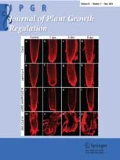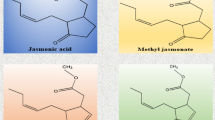Abstract
Pyridine 2,4-dicarboxylate (PDCA) is a structural analog of 2-oxoglutarate and a potent inhibitor of 2-oxoacid-dependent dioxygenases (2-ODDs), such as prolyl 4-hydroxylases (P4Hs). It has been reported that PDCA inhibited the in vitro activity of P4Hs in cut carnation flowers and delayed petal senescence due to suppression of climacteric ethylene production. In this study, the effect of PDCA on ethylene evolution in response to mechanical wounding due to excision of mature green tomato pericarp discs was investigated. Ethylene evolution was induced within 1 h of mechanical wounding in control discs and gradually increased throughout 24 h, whereas it was partially suppressed in PDCA-treated discs during the first 12 h of a 24-h experimental period. This transient, partial suppression of ethylene production can be attributed to the lack of induction and the downregulation of ethylene biosynthetic genes within 1 h and after 12 h of wounding, respectively. However, it cannot be attributed to the suppression of ACC oxidase, a well-known 2-ODD, because no significant change in enzymatic activity was observed in PDCA-treated discs. In addition, the transcript abundance of wound-induced and ethylene-regulated PIN1, PIN2, and E4 genes was also partially suppressed in PDCA-treated discs. PDCA was also shown to be involved in ethylene evolution and color development of mature green and turning fruit discs. Overall, these results indicate that PDCA downregulates ethylene production in response to mechanical wounding and during ripening of preclimacteric and climacteric tomato fruit discs.






Similar content being viewed by others
References
Alexander L, Grierson D (2002) Ethylene biosynthesis and action in tomato: a model for climacteric fruit ripening. J Exp Bot 53:2039–2055
Bachem CWB, Oomen RJFJ, Visser RGF (1998) Transcript imaging with cDNA-AFLP: a step-by-step protocol. Plant Mol Biol Rep 16:157–173
Bowles D (1998) Signal transduction in the wound response of tomato plants. Phil Trans R Soc Lond 353:1495–1510
Bradford MM (1976) A rapid and sensitive method for quantitation of micro quantities of protein utilizing the principle of protein-dye binding. Anal Biochem 72:248–258
Campbell AD, Huysamer M, Stotz HU, Greve LC, Labavitch JM (1990) Comparison of ripening processes in intact tomato fruit and excised pericarp discs. Plant Physiol 94:1582–1589
Cara B, Giovannoni J (2008) Molecular biology of ethylene during tomato fruit development and maturation. Plant Sci 175:106–113
Cheong Y, Chang H, Gupta R, Wang X, Zhu T, Luan S (2002) Transcriptional profiling reveals novel interactions between wounding, pathogen, abiotic stress, and hormonal responses in Arabidopsis. Plant Physiol 129:661–677
Díaz J, ten Have A, van Kan JAL (2002) The role of ethylene and wound signaling in resistance of tomato to Botrytis cinerea. Plant Physiol 129:1341–1351
Fragkostefanakis S, Dandachi F, Kalaitzis P (2012) Expression of arabinogalactan proteins during tomato fruit ripening and in response to mechanical wounding, hypoxia and anoxia. Plant Physiol Biochem 52:112–118
Kaska DD, Günzler V, Kivirikko KI, Myllylä R (1987) Characterization of a low-relative-molecular-mass prolyl 4-hydroxylase from the green-alga Chlamydomonas reinhardii. Biochem J 241:483–490
Kaska DD, Myllylä R, Günzler V, Gibor A, Kivirikko KI (1988) Prolyl 4-hydroxylase from Volvox carteri. A low-Mr enzyme antigenically related to the alpha-subunit of the vertebrate enzyme. Biochem J 256:257–263
Lancaster JE, Lister CE, Reay PF, Triggs CM (1997) Influence of pigment composition on skin color in a wide range of fruit and vegetables. J Am Soc Hortic Sci 122:594–598
Lincoln JE, Cordes S, Read E, Fischer RL (1987) Regulation of gene-expression by ethylene during Lycopersicon esculentum (tomato) fruit-development. Proc Natl Acad Sci USA 84:2793–2797
Lincoln JE, Campbell AD, Oetiker J, Rottmann WH, Oeller PW, Shen NF, Theologis A (1993) Le-ACS4, a fruit ripening and wound-induced 1-aminocyclopropane-1-carboxylate synthase gene of tomato (Lycopersicon esculentum): expression in Escherichia coli, structural characterization, expression characteristics, and phylogenetic analysis. J Biol Chem 268:19422–19430
Livak KJ, Schmittgen TD (2001) Analysis of relative gene expression data using real-time quantitative PCR and the 2-ΔΔCt method. Methods 25:402–408
Mekhedov SL, Kende H (1996) Submergence enhances expression of a gene encoding 1-aminocyclopropane-1-carboxylate oxidase in deepwater rice. Plant Cell Physiol 37:531–537
Montgomery J, Goldman S, Deikman J, Margossian L, Fischer RL (1993) Identification of an ethylene-responsive region in the promoter of a fruit ripening gene. Proc Natl Acad Sci USA 90:5939–5943
O’Donnell PJ, Calvert C, Atzorn R, Wasternack C, Leyser HMO, Bowles DJ (1996) Ethylene as a signal mediating the wound response of tomato plants. Science 274:1914–1917
Peña-Cortéz H, Albrecht T, Prat S, Weiler EW, Willmitzer L (1993) Aspirin prevents wound-induced gene expression in tomato leaves by blocking jasmonic acid biosynthesis. Planta 191:123–128
Rojo E, Solano R, Sanchez-Serrano JJ (2003) Interactions between signaling compounds involved in plant defense. J Plant Growth Regul 22:82–98
Ryan CA (2000) The system in signaling pathway: differential activation of plant defensive genes. Biochim Biophys Acta 1477:112–121
Smith JJ, Ververidis P, John P (1992) Characterization of the ethylene-forming enzyme partially purified from melon. Phytochemistry 31:1485–1494
Starrett DA, Laties GG (1993) Ethylene and wound-induced gene expression in the preclimacteric phase of ripening avocado fruit and mesocarp discs. Plant Physiol 103:227–234
Tatsuki M, Mori H (1999) Rapid and transient expression of 1-aminocyclopropane-carboxylate synthase isogenes by touch and wound stimuli in tomato. Plant Cell Physiol 40:709–715
Tiainen P, Myllyharju J, Koivunen P (2005) Characterization of a second Arabidopsis thaliana prolyl 4-hydroxylase with distinct substrate specificity. J Biol Chem 280:1142–1148
Ververidis P, John P (1991) Complete recovery in vitro of ethylene-forming enzyme activity. Phytochemistry 30:725–727
Vlad F, Spano T, Vlad D, Bou Daher F, Ouelhadj A, Kalaitzis P (2007) Arabidopsis prolyl 4-hydroxylases are differentially expressed in response to hypoxia, anoxia and mechanical wounding. Physiol Plant 130:471–483
Vlad F, Tiainen P, Owen C, Spano T, Bou Daher F, Oualid F, Senol NO, Vlad D, Myllyharju J, Kalaitzis P (2010) Characterization of two carnation petal prolyl 4-hydroxylases. Physiol Plant 140:199–207
Yokotani N, Tamura S, Nakano R, Inaba A, McGlasson WB, Kubo Y (2004) Comparison of ethylene- and wound-induced responses in fruit of wild-type, rin and nor tomatoes. Postharvest Biol Technol 32:247–252
Author information
Authors and Affiliations
Corresponding author
Rights and permissions
About this article
Cite this article
Fragkostefanakis, S., Kalaitzis, P., Siomos, A.S. et al. Pyridine 2,4-Dicarboxylate Downregulates Ethylene Production in Response to Mechanical Wounding in Excised Mature Green Tomato Pericarp Discs. J Plant Growth Regul 32, 140–147 (2013). https://doi.org/10.1007/s00344-012-9286-4
Received:
Accepted:
Published:
Issue Date:
DOI: https://doi.org/10.1007/s00344-012-9286-4




